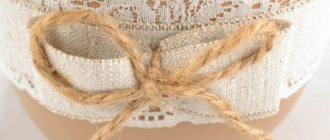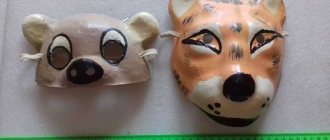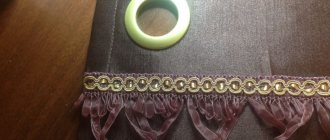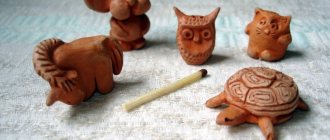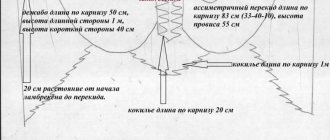How to make an authentic wigwam for children with your own hands in just an hour?
Let's not forget that a wigwam is an Indian dwelling made of animal skin, linen, sticks and ropes. Leaving buffalo skins aside as an exotic material, let's stock up on a linen, curtain or bright bedspread the size... about the size of a long sheet. You will also need structural parts and tools:
- The canvas is approximately 1.5 m x 2.5 m.
- Rope (or strong braid) – 1-2 m.
- Sticks 1.2-1.7 m long - 3 pieces.
- Pencil.
- Scissors.
- Drill.
- Glue (it is convenient to use a glue gun).
- Thread and needle.
Materials for a wigwam
Important! The structure should be stable, and the sticks should be light and without sharp ends (because the wigwam will still fall periodically, and it should not harm its owner).
Sticks should be light and without sharp ends
A gap should be left in the upper part so that the smoke of the fire on which the meat of the wild goat was fried comes out, and during the day the sun's glare plays on the walls of the tent. If your child is not interested in stories about Indians, tell him about the starry sky, a piece of which he can admire on a cool evening. Or simply explain that ventilation is needed - it all depends on the child’s and adult’s imagination.
Build a wigwam as a family
A masterpiece must be created together. This is fundamentally important. Because only joint work, with hustling and smearing with glue, truly unites the family and makes them fall in love with the wigwam that will be made for the children with their own hands.
Materials and tools for work
Making a wigwam can be an economical affair if you rationally calculate in advance what you need to buy. Materials and tools for work are available to everyone and can even be found at home by a novice designer.
For production you will need the following materials:
- 4 wooden round sticks or PVC pipes;
- beautiful thick fabric to sew a cover. Preferably it should be natural;
- rope or rope (you can choose a beautiful decorative one, the main thing is that it should be strong and not slip);
- threads to match the material.
The only tools you will need are scissors, a drill and a sewing machine, if you have one, to sew the cover.
In addition, you will need a little imagination, inspiration and seamstress talent.
Frame installation
First you need a frame. It should not move apart, so you need to fix the angle of the sticks.
Measure 20 cm from the top end of the sticks and mark a cross with a pencil.
Drill a hole on each stick at the mark.
Pull the cord (rope, ribbon) through all the holes.
Pull the cord through the holes
Give the frame the appearance of a regular pyramid.
Tighten the rope by one knot and wrap it around the intersection of the sticks very tightly, in several turns. Dad's super strength will come in handy. All this time, mother and children must keep the legs of the wigwam in the desired position - otherwise a rigid structure will not work.
Wrap a rope around the intersection of the sticks
Important: especially resourceful parents coat the places where the sticks touch with glue.
You can leave the frame alone for 10-20 minutes so that the glue dries and dad rests.
Apply glue to the places where the sticks touch
The next stage is stretching the skin onto the frame. How to do it? Usually the best solution is also the simplest.
So, the starting position: the frame is ready and stands so that it has two sides and one front, on which there will be an entrance.
Covering a wigwam without sewing
The first way of covering - it couldn’t be simpler:
Bend the canvas to a width at which it hangs at the bottom on the floor on the sides, and at the top does not reach the crosshair line of the sticks by 10-15 cm.
Throw it over the posts, and an overlap will form above the entrance to the hut - it should not overlap the side walls, so the front of the fabric may need to be folded.
Drape the fabric over the posts
Mark the line of the top edge of the fabric on the sticks with a pencil.
After fitting, move the canvas down (there are a lot of people at the construction site, someone will support it).
Lubricate wooden sticks with glue from the line of marks 15-20 cm down.
Place the fabric along the top marks, press it to the posts coated with glue, and let it dry.
Attach the fabric to the posts coated with glue
To form an entrance - sew pieces of braid (ropes) onto the edge of the canvas and in the area of the sticks, so that you can swing open the entrance, or close yourself in a children's wigwam, which you just managed to make with your own hands.
DIY wigwam for children without sewing
latest comments
everything is very interesting and accessible I liked it
Hi all! Today we will become real builders! I think that after what we do to you today, our children will be truly proud of us! What kind of program awaits us today? DIY wigwam patterns sizes! Did you have houses or tents when you were a child? I'm sure they were! No one grew up without having their own house, their own personal space! So, let's go?
But first things first! First, it’s worth saying a few words about what a house for a baby is. Why does he need it and how can we help our little ones. And then a master class awaits you! Not just one, but 3 at once! I have made a selection of three wonderful models of wigwams that are assembled in different ways. You can choose exactly the one that you like best, that suits you and that seems more accessible to you.
How to sew a sustainable wigwam for children
This method of covering is more complicated, but the wigwam will keep its shape better.
Measure the sides of the triangle walls.
Cut four pieces of fabric to these dimensions, adding 7 cm on each side.
Cut triangle walls to size
Sew them together, leaving one side unstitched - this will be a swing door. In total you will get 3 seams with large allowances - 6-7 cm on each side
Sew them together
Sew the allowances along the edge so that you get a drawstring into which the stick will be inserted.
Sew the drawstrings into which the palis will be inserted
Trim the top edge by 10-15 centimeters - this will be the hole “under the ceiling” of the tent. Finish the edge - overcast or hem.
Stretch the tent from below onto the poles. Glue it to the wood at the top.
Stretch the tent from below onto the poles
The entrance to the wigwam is covered with two sheets, which can be folded over the racks or closed, closing the entrance.
A small improvement significantly strengthens the structure: just on the entrance side, connect two posts at the bottom with tape (you will need glue). It should be attached to the sticks as close to the floor as possible so that the child does not stumble. What does this give? The racks will not be able to move in different directions.
DIY sustainable wigwam for children
How to sew a mattress into a wigwam for children
We advise you not to do complex cutting, but to sew a square mattress. You can use a large pillowcase. If you put a 10-20 mm sheet of foam rubber into it, the frame will stand on top. If there is a piece of synthetic padding in the pillowcase, the mattress will be soft and can be placed inside the wigwam by tucking the corners.
The mattress will make the wigwam warm and cozy
A mattress is a must – it encloses the space, it is warm and cozy. With it, a wigwam, sewn with your own hands for a child, turns into a house, a nest, a cave, a secret shelter - depending on the circumstances.
The most interesting: DIY wigwam decor
How to decorate a new wigwam? First of all, a good choice of fabric. If it is not decorative enough, you can sew or glue strips of textiles, braid, or fringe onto it.
Decorate the edges of the wigwam with decorative braid
You can hang three multi-colored paper flags on the upper ends of the sticks or place a bunch of feathers on the top.
Flags on the top ends of the sticks
Garlands of multi-colored light bulbs turn the wigwam into a magical tent, the embodiment of a dream and a holiday.
Garlands will turn the wigwam into a magical tent
Sometimes a window is cut into the wall, but this is not necessary. In general, the process of decorating and improving the wigwam is endless - the child himself will be doing this for a long time. Parents have only one thing left to do: not interfere and sometimes help implement new ideas.
You can cut a window in the wall
About the wigwam - history of origin and features
The history of the wigwam begins long before the arrival of Europeans to the American continent and even before the emergence of the powerful empires of the Mayans, Incas and Aztecs. The technology of housing construction varied depending on the climate: Indians inhabited all of America, both North and South - from the polar regions to the equator. There were also other types of traditional Native American housing, such as the wickiup and teepee. Based on the execution method, the wigwam can be described as a dome-shaped hut. They reached large sizes and were intended to accommodate up to 30 people. The base of the dwelling was assembled from thin flexible branches. It was covered with large or small fragments of tree bark. For these purposes, the Indians used elm and birch. The structure was also covered with reeds, grass, and corn leaves. The top layer was sometimes pressed with another frame, the outer one.
Wigwam in the interior of a children's room
In a children's room, a wigwam will become a place of solitude for the child. It doesn’t matter whether this room is for two children or for one, the baby still needs a house that is commensurate with himself, and not with the world of adults. There you can talk secrets with the shaggy bear, look at a book, and just fall asleep on the mattress.
The wigwam will become a place of solitude for the child
The wigwam fits into the classic Scandinavian interior like a native one - it goes well with the light aesthetics of minimalism. Even the fabrics offered by Scandinavian designers come with appropriate prints: stylization of Indian ornaments, “snakes”, corners, etc.
Wigwam in a Scandinavian interior
If a boy’s nursery is designed in a marine or ecological style, then you can use safari colors in the design of the wigwam, decorating it as a camping tent.
Wigwam for a boy in khaki color
In a glamorous girl's bedroom, a wigwam can be transformed beyond recognition, turning into a delicate tent. You can choose silk fabrics for it, and decorate it with ruffles, and use all shades of pink. Why not? If you make a wigwam for a nursery with your own hands, then it will be one that will take the child’s breath away.
Delicate lace wigwam for girls
Hut made of branches and living plants
Such a hut can be built where you have the opportunity to grow some plants. For example, at the dacha. To do this, you will need high poles that need to be driven into the soil in a circle - this will become the frame of the future unusual hut, which will delight all your guests and friends. Sow seeds of climbing plants, such as grapes, morning glory or clematis, along the entire length of the frame. The obvious drawback of this method of construction is the long period of plant growth, which makes this type of hut uninteresting for a child.
There is a faster way to build a hut from a plant. For example, it can be made from willow. To do this you will need a lot of long branches, and the longer the branches, the higher the hut will be. It is not difficult to build it at all. Just drive the branches into the soil, and tightly intertwine the tops with each other. To compact the walls, you can cover them with spruce branches or regular straw.
READ ALSO: Which Pipe to Make a Safety Frame From
